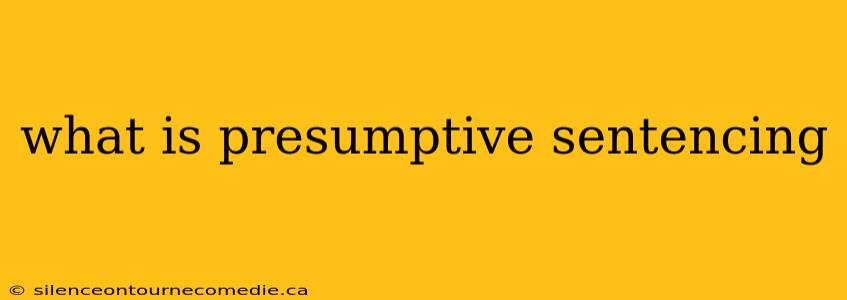Meta Description: Discover the intricacies of presumptive sentencing. This comprehensive guide explains what it is, how it works, its pros and cons, and how it differs from other sentencing models. Learn about its impact on the criminal justice system and potential reforms. (158 characters)
Presumptive sentencing is a sentencing structure where judges have a suggested range of punishment for specific crimes. This range is usually determined by factors like the severity of the crime and the offender's criminal history. While the judge has some discretion within that range, significant departures require justification. It aims to create more consistency and fairness in sentencing, reducing disparities between similar cases.
How Presumptive Sentencing Works
Presumptive sentencing guidelines are usually established by legislative bodies or sentencing commissions. These guidelines often incorporate a scoring system, considering various aggravating and mitigating factors. Aggravating factors, such as the use of a weapon or prior convictions, could lead to a harsher sentence within the presumptive range. Mitigating factors, like a lack of criminal history or remorse, could lead to a lighter sentence.
Understanding Sentencing Guidelines
The guidelines aren't necessarily mandatory. Judges retain some discretion to deviate from the presumptive range. However, they are generally expected to provide a clear and compelling reason for any departure. This ensures accountability and transparency in the sentencing process. These reasons are often documented and reviewed to maintain consistency.
The Role of the Judge
While guidelines provide a framework, judges retain crucial decision-making power. They consider individual circumstances and apply the guidelines accordingly. The judge's interpretation of the law and the facts of the case remains paramount.
Advantages of Presumptive Sentencing
- Increased Consistency: Reduces disparity in sentencing for similar offenses, promoting fairness.
- Transparency and Accountability: Provides clear standards, making the sentencing process more predictable and understandable.
- Reduced Judicial Discretion: While some discretion remains, it’s more structured and accountable.
- Potential for Sentencing Reform: Allows for data-driven adjustments to sentencing practices based on effectiveness.
Disadvantages of Presumptive Sentencing
- Rigidity and Inflexibility: May not adequately account for unique circumstances in individual cases.
- Potential for Overly Harsh Sentences: Could lead to disproportionately long sentences, especially in cases with aggravating factors.
- Increased Burden on Judges: Requires careful consideration of guidelines and justification for any deviation.
- Concerns about Racial Bias: If not carefully crafted, guidelines might inadvertently perpetuate existing biases in the criminal justice system.
Presumptive Sentencing vs. Other Sentencing Models
Presumptive sentencing differs significantly from other models. Mandatory minimum sentences, for instance, leave little to no judicial discretion. The judge must impose a minimum sentence regardless of individual circumstances. Indeterminate sentencing, on the other hand, allows for significant judicial discretion, often with broad ranges of possible sentences. This can lead to greater inconsistencies.
Presumptive sentencing aims to find a balance, providing structure while allowing for consideration of individual factors within a defined framework.
Questions and Answers about Presumptive Sentencing
Q: Can a judge ignore presumptive sentencing guidelines entirely?
A: Generally no. While judges retain some discretion, they must justify any significant departure from the guidelines. Arbitrary or unexplained deviations are often challenged.
Q: What factors are typically considered in presumptive sentencing guidelines?
A: Factors often considered include the severity of the crime, the offender's criminal history, the presence of aggravating or mitigating circumstances, and any relevant social or psychological factors.
Q: How effective is presumptive sentencing in reducing crime?
A: The effectiveness of presumptive sentencing in reducing crime rates is a complex issue with mixed results depending on the specific implementation and other factors. Studies suggest it can lead to more consistent sentencing, but its impact on crime rates is debated among researchers.
Potential Reforms and Future Directions
Ongoing discussions surround potential reforms to presumptive sentencing. These often focus on addressing potential biases, improving the accuracy of risk assessment tools used in guideline creation, and increasing transparency and public participation in the guideline-setting process.
Conclusion
Presumptive sentencing represents a complex approach to criminal justice. It strives for balance, offering structure and consistency while allowing for some consideration of individual circumstances. However, ongoing discussion and reform are necessary to ensure fairness and effectiveness in its application. Understanding the intricacies of presumptive sentencing is crucial for anyone involved in or interested in the criminal justice system.
